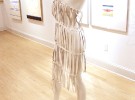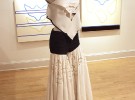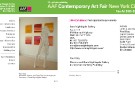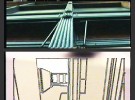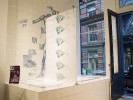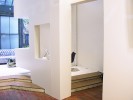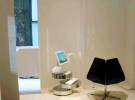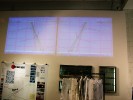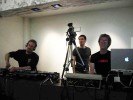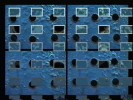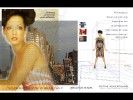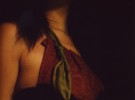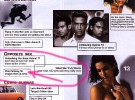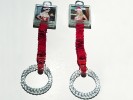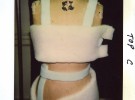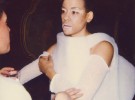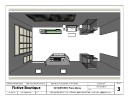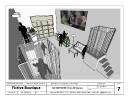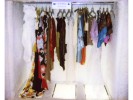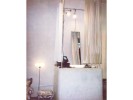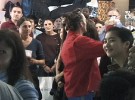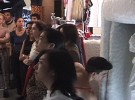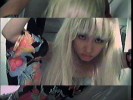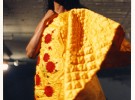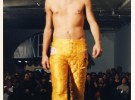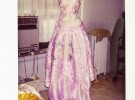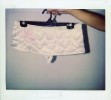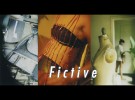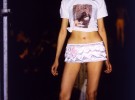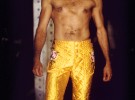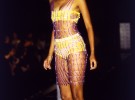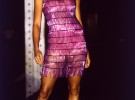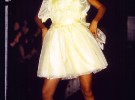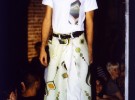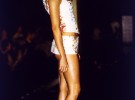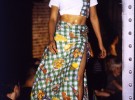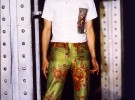Presented in the group art exhibit “Beautiful, Male, Objects” at Sarah Nightingale Gallery, South Hampton, NY, 2004.
Â
Wearable Objects-Project Description
This work came out of the some of the same set of interests that fueled the Fictive Runway project. I had a continued fascination with cheap found or store-bought items which could be incorporated into contemporary fashion, both to acknowledge their beauty, and also to revalue the lingering traces of craft practices still to be found in mass produced objects.
Watchbandwear: The first of the three works is made from a sheet of white leather, found in the trash on the street. It is from a company that was producing watchbands for children’s watches, and the piece is the left over, after the items were cut from it. The dress works almost like an apron, with a simple ribbon at the back for closure. As a result of the crisscross it also reads a little like lingerie.
Tablewear: The second work is made from two table cloths and a napkin, along with blue jean fabric. This piece has amazing movement properties when worn, with the legs of the pants functioning almost like a bolero dress for flamenco dancing. It also has a “country” feel, but with an exposed back and open slots near the breast and midriff, also reads as sexy club-wear.
Jumpropewear: The third work is made from children’s plastic jump ropes, white trevira voile, and elastic waistband material, like that used for simple cotton underwear. This piece is entirely un sewn, and was made using knitting needles to pierce the elastic band and with the trevira voile knotted to it.
You Are Here – architecture, retail, and locality:  an art installation and live audio/video performance contemplating the neighborhood of SoHo and the nature of shopping and retail design, created for the Diesel Denim Gallery, a clothing store where 70% of the space is devoted to the presentation of art, and which is located in the SoHo neighborhood of New York City.
Â
Project Description:
There are seven basic elements of the installation:
1. Foam Core Wall:
A 40 foot long by 12 foot high fake wall built from 1/2″ Foam core. It is a one to one scale replica of the actual wall opposite to it, but in mirror image. The wall promotes the idea of the store existing as much in the design phase as a foam core white model as it does in the “real” phase. The mirror image is also a kind of reference to the mental inversion of the “Gruen Transfer”.
2. Floor Sticker:
The 22 foot long vinyl floor sticker with a red dot and the phrase “You Are Here” refers to both the placement locator help found on maps in public spaces, but (like the foam core wall) also serves to suggest that the shoppers are not in an actual space but a space modeled around them and to control them. As though they are ant sized in a model box designed to look like a store. The fact that part of the sticker seems to be sitting underneath the actual brick interior wall of the store serves to further dematerialize the structure.
3. Plexiglas Plaques:
Six hanging C prints on plexiglas 32″x48″ which contain elements of text, and when taken together say the following: “Shopping can be a disorienting experience. Have we found the right place to fulfill our dreams? Where are we in socio-architectural terms when we are in Soho shopping? You are Here.”
4. Clothing rack hanging Plaques:
1/8 inch thick, 24 inch by 30 inch mat white plastic plaques, designed to hang among the clothing that was being sold. These are intended to be roughly the same size as the garments themselves and are hung on hangars, just like the clothing. Text written in black marker in Seven different languages: English, Spanish, French, German, Italian, Japanese, and Korean, gives pointed information about the historical development of retail architecture and the effects on shopping. (This turned out to be a particularly effective intervention in that Soho is filled with tourists and with so little support in the US for foreign visitors, they strongly gravitated to, and took interest in, something written in their native language.)
5. Map of retail development and in-store design:
A 73 inch wide by 77 inch high hanging map printed on the vinyl used for architectural “building wraps” (the very large scale billboards on the exterior of buildings) displaying visual details about the interior and exterior of the store, details about the individual interventions in the installation, text info about the neighborhood and the history of shopping, and time lines for the Evolution of Retail Mechanisms, Retail History, and the Diesel Denim Gallery. Important developments such as Joseph Paxton’s Crystal Palace, and the first know use of mannequins are noted. The history is tracked into possible futures including synthespian sales staff.
6. Satellite view of the store with data overlay:
Hanging print of Satellite view of the neighborhood along with data overlay relating to retail space use in the neighborhood of Soho.
7. Interactive 3D Fly through:
A computer and projections at the back of the store, behind the foam core wall containing an interactive 3D fly through of the store with slabs floating in space giving information on everything from the number of daily visitors to the store, to the amount of air that passes through the air conditioning system each month.
8. Video projection:
Video projection from three projectors, of the video collage made during the live mix performance, Which included a walk and drive through of SoHo, close ups of design details about the store, text on retail Design, live video of the audience in the space, and 3d fly through of the info time lines.
Â
Project Description:
When I was first approached by curator Sebastien Agneesens about the possibility of creating a work for the Diesel Denim Gallery I thought, what kind of artwork could possibly stand up to the retail environment and not get eaten by it, not turn into advertising for the products around it? I decided the only likely work would take on the structure of retail architecture itself, as a subject, and though it would still be ground up and consumed, it might transmit its meaning virally in the process.
As is pointed out in the brilliant and encyclopedic tome “The Harvard Design School Guide to Shopping”, shopping is everywhere these days. The museum, the airport, the nightclub, the university. Shopping is blending with or replacing, almost every kind of urban activity and has become one of the main ways we experience life in a city.
Though shopping is one of the most temporary and unstable types of urban activity, contemporary cities are attempting to use it as the main building block or foundation for civic life. Shopping is not a viable alternative to fundamental communal activities and services, because it doesn’t necessarily last. Shopping has a vital place in society but should not be made to do the job of institutions.
Shopping architecture is cheaply made because like fashion it must constantly change. Buildings can last for 5000 years, but shopping architecture is currently typically viable for only about 3 years before it must be completely transformed into something new.
The timeline for retail development is so brief that stores go from model to completion to obsolescence in almost no time at all. Retail architecture is ephemeral, lasting a brief moment. Existing as much in the design and model phase as in the actualized phase, the store itself is there for such a brief time in historical terms as to make it like a momentary reflection, like a model, hardly real.
Even when realized, retail architecture is often so cheaply built as to be a facade. Like a Hollywood back lot. Like a movie set.
The store exists as much as data as it does as physical building materials. Realtime information tracking, computer modeling of consumer behavior, constant monitoring of shoppers through multiple forms of surveillance media. The store as a virtual and data construction is much larger and more real in some ways than the puny physical location. Even the idea of “brand” and the projection of brand out into the world as advertising can be considered part of the virtual extension of a store.
But the physical locale has its advantages and has a depth and breadth unknown to the virtual trackers. The window washer who wants to address issues of race with passers-by. The gum on the sidewalk that records a trace of the life of a breathing person at this locale, the stone, the iron, the rain on your face. The beauty of being alive in the present moment.
Shopping spaces are designed to delight, but also to confuse and mesmerize. In retail architecture huge amounts of time, money, and research is devoted to this. Scripted disorientation is used to actively confuse shoppers so that they become more susceptible to making impulse purchases. The Gruen Transfer, (named for the first shopping mall designer,) is a psychological state where movement slows, eyes glaze over, jaws slacken and the mind temporarily ceases to function properly because it is experiencing too much input. The exact distance in feet and the number of seconds it takes to induce this debilitated state is actively measured in contemporary retail design.
In ancient times there was a market outside the borders of the city. People went there to exchange goods. There was no buying and selling organized inside the town. In the current era shopping is one of the major forms of urban activity. Imagine a modern city where there was no shopping. What kinds of activities would you do in a city like that? What would be important? What would you care about and devote time to? What might constitute meaningful civic and urban interaction?
Shopping, like advertising can’t simply be discontinued because it is being used in contemporary society to fill deep seated needs, and there are currently few social structures to replace it. If we at least begin to become aware of the lengths to which designers go to alter our consciousness as we go about the process, then we can begin to shape our own outcomes from the experience.
Toward this goal, the project records, through multiple forms of digital media, the local environment in the neighborhood surrounding the gallery. It gathers, in this case, intimate details of life in Soho, New York. In addition it creates an architectural and mediatic intervention into the actual space. Research on the historical development of retail, information flows, the nature of shopping and the meaning of place is presented in dynamic visual, audible, and textual form, heavily layered and worked.
Media forms include a stripped back 3D computer model of the entire store with text replacing products, a 3D data map of retail and shopping, satellite photographs, digital video, still photography, and audio samples. All these mediatic elements are combined in an A/V performance work created live, in the gallery, and then subsequently on display for the duration of the installation.
Shopping can be a disorienting experience when we are offered so many possibilities regarding place, design, and personal style. Have we found the right place to fulfill our dreams? Where are we in local, architectural, geographical, virtual, and cultural terms when we are wandering around in Soho, shopping? The project gathers the mediatic traces, then lays it all out for you. At the Diesel Denim Gallery – YOU ARE HERE
Credits:
Concept and realization: Paul Clay with curator Sebastien Agneesens
Live Video Mix:Â
Video – Paul ClayÂ
Audio – Arrow Chrome
3D Data Mapping: Jose Salinas, Architect, founder of Knobs Design
3D Animation: Paul Clay, Willyum Delirious, Jose Salinas
Publicity for Fictive: Berit Fischer, Naiying Kuo
Installers for Fictive: Julie Allen, Mark Power, Chang-Jin Lee, Yukiko Hayakawa
Translations for Hand Written texts: Jose Salinas, Yukiko Hayakawa, Sebastien Agneesens, Berit Fischer, Julie Allen, Chang-Jin Lee
Curated by: Sebastien Agneessens – Formavision
Special thanks to all the people at Diesel, from those at the top who approved this thing to those who did publicity, install, letting us in after hours, and supporting us as we did the work. You made this event possible. Thank You.
You are Here is a project of Fictive, a loose constellation of multi-disciplinary art creators, and a kind of fictional arts collective founded by Paul Clay and composed of whoever happens to be working on aproject at any given moment.
Fictive Advertising – Conversion of periodical literature to product message delivery systems.
Â
A two page magazine spread, presented in NY Arts magazine, created as an artwork intended to critique magazine advertising.
Image Samples:
Download Medium Resolution PDF File:
Fictive_Advertising PDF
Â
Project Description:
Business/Economics, Symbol Systems/Myths and Dreams.
“The major media are large corporations, owned by and inter linked with even larger conglomerates. Like other corporations, they sell a product to a market. The market is advertisers – that is, other businesses. The product is audiences for the elite media, relatively privileged audiences. So we have major corporations selling wealthy and privileged audiences to other businesses. Not surprisingly the picture of the world presented reflects the narrow and biased interests of the sellers, the buyers, and the product.” – Noam Chomsky.
Culture jammers have been making fake ads for a while now. They usually involve hacking of a specific ad or campaign. “Subvertising.” Part of the hack is usually to attack a particular brand. With fashion “subvertisements” the most common ones are Calvin Klein and Tommy Hilfiger. Though this is powerful and effective, in some sense it’s like what Naomi Klein, author of “No Logo,” says about attacking corporations. A specific Multinational works as a handle to grab on to or rally against in order to get a point across, but the real problem which needs addressing is the hugely complex structure of global capital and trade agreement formation.
The problem is twofold. Part of the issue is the economics, and part of the issue is the meaning or symbol system. John de Graaf, Thomas Naylor, David Wann in their book “Affluenza: The All-Consuming Epidemic” describe consumerism as “a painful, contagious, socially-transmitted condition of overload, debt, anxiety and waste resulting from the dogged pursuit of more.” Yet people aren’t stupid, so what is going on?
Advertising is an important part of the structure. Its relation to the larger issue of global economic exploitation needs to be understood. In one way it can simply be read as giant corporations trying to poison our thoughts so that we consume endlessly more product. Yet a solely economic analysis of advertising does not get at the whole of the problem. Equally important is its fundamental relation to meaning in our culture. Advertising is amazing. Advertising is beautiful. Advertising uses what we care about, the deep seated and fundamental beliefs and longings in our culture. We have to see that advertising, for better or worse, is carrying a huge part of our cultural canon right now.
In the 1980’s people finally admitted to themselves that the point of businesses is not to provide products or services. The point is to make money. Because money, not service, is the ultimate goal, a bad product or service is just as effective as a good one, or none at all, if it makes money for the corporation. Provision of product or service is tangential to business. The two may happen to be in confluence at times but there is no guarantee or even need for them to be. It’s quite possible that the less of a product you have and the less you pay workers to produce it the more profit you garner.Â
Similarly, advertising is not about a product or service, but rather about getting as many people as possible to consume. It is not the product which is sold but the sense of a lack in the potential consumer. A combination of a dream and a sense that it is as yet unfulfilled – and that consuming will consummate the new hope or dream. People focus on this rather than other types of activity which might be helpful for them, but which might disrupt the status quo. This is the heart of the second part of the problem, the symbol system.
As Andrew Boyd of the culture-jammer mime campaign “Billionaires for Bush (or Gore)” notes “advertising imagery is the ultimate stealth virus. It has long been post or pre rational, operating by subconscious association, by veiled promise and threat, by mobilizing our longings and our dream world. Rational critique can’t find a handle by which to challenge such a worldview.”
Though advertising can seem trivial, it is actually carrying inside it our most prized beliefs. Further, it is one of the main avenues of dissemination for these important cultural concepts. Some of the finest artists in the world work in it, and they receive a great deal of prestige and recognition for doing so. It is in some way similar to shamanistic practice in folk societies. Not that it is arcane or inscrutable but rather that it involves practitioners or technicians who must get at the heart of the collective dreams within a culture and then harness these. The sacred practitioners do it partly for their own ends, but also to move the culture forward in some ideal path they perceive as right, based on their reading of the dreams and traditions.
Fashion, too, can seem frivolous and inconsequential, yet when anthropologists study a culture, the clothes they wear, and the daily things they surround themselves with, tell a tremendous amount about who they are, how they live, what they care about, and how they see their place in the cosmos.
A lot of how we understand the world still comes from myths buried deep in our general culture’s understanding. Advertising works on these myths, within the subconscious symbol system. Brands are little different from Totems. Providing strength, coherence, a path or organizing principle – a community of the like minded. A special society or group, separate from the others, a definition of self.
I don’t think there can be an easy dismissal of advertising, despite its huge negative impact on creating a sustainable future, because its function is so central to our social structure and because it is working directly with our core cultural beliefs. The key is to acknowledge the beauty and at the same time critique the structure.
Rather than spoof a particular brand, “Fictive Advertising” is an attempt to make reference to a host of styles, reflecting the entire genre of advertising. The use of the sexy dresses is an allusion to couture and high end ready to wear. The architecture refers to the anomic landscapes and empty urban environments used to promote hip hop sportswear. The little boxes and multi-section layout come from interior design ad aesthetic, and the wire frame or spot illustration comes out of youth culture alt/skate punk lifestyle looks.
Economic exploitation around the globe causes hate at being oppressed. We are belatedly waking up to this obvious fact. Terror is not justifiable. Ever. Period. We as a culture are not to blame for terror. It is also a poor tactic in that it leads to more oppression. Yet the problem is that human suffering and human rights violations are coming back to haunt us, as normal people in exploited nations choose to support fanatics as the only way they see out of their own oppression. If they were actual participants in the largess of the global economic structure they wouldn’t want to destroy it, as they would be hurting themselves. Instead, we get the hard earned value of their labor, and they are left hopeless and desperate. Meanwhile, we are constantly encouraged to want to get more. All of this economic truth is also hiding behind ads.
Despite the concerted efforts of the World Bank and the WTO, I do not believe there is a Global Conspiracy of Western Corporate Industrialism to destroy the World nor of Advertisers to steal our minds. Rather there is an organic cultural process which we can ignore and allow to occur or which we can recognize, and attempt to alter. The first step in changing anything is to understand it. Like the Wizard of Oz, it may look big and shiny, all-powerful and inscrutable, but it is actually operating with basic processes, with gears and levers that we can grasp.
Kalle Lasn of the venerable ADBUSTERS notes “right now, corporations have the power. They beam their memes into our brains at the rate of a few thousand ads, brand logos and marketing thrusts per day.” and further “Every outburst of cognitive dissonance is useful, but to mount a serious challenge against corporate rule, we jammers must build our own meme factory. Because we have severely limited budgets, our strategies must be perfectly crafted to tear gaps in the glitter of the consumer spectacle.”
Jump in and work the stuff over. Squeeze it a little and see what pops out. Get out the scissors and start shaping. Fictive advertising: Doing our part to tear a few gaps in the glitter. Making some new glitter. Paying a little attention to the man behind the curtain…
Credits:
Conceived and Created by Paul ClayÂ
Layout and design by Paul Clay and Jamie LeoÂ
Fashions: Paul ClayÂ
Styling: Star Studio ProductionsÂ
Photo: Jo Lance www.jolancephoto.comÂ
Make-up: Yukiko Takagi and CadilacÂ
Model: Annalyce
Special thanks:
Abraham Lubelski, Kazue Soma, and everyone at NY Arts Magazine.
Fake Fashion Photos from Fictive Boutique
Â
Project Description:
This came out of some of the work done for the Fictive Boutique project. At the time that exhibit was mounted we had contemplated doing some fake fashion photography to accompany it. In the end we decide to wait on that part of the idea, and came back to it later.
Here a series of pieces of clothing which were part of the installation on Elizabeth Street are used to create a set of seeming fashion photos.
Credits:
Photography – Paul Clay
Clothing Design – Yukiko Takagi
Models – Mayumi and Miho
Actual fashion shoot for the first issue of a new L.A. based Latin men’s magazine, incorporating fictional clothing.
Images of the magazine pages:
Fictive Tear Sheet-Project Description
The term “tear sheet” refers to a picture of a fashion designers work which appears in a magazine, and can then be torn out and displayed to show the designer is being successful.
This particular project happened quite serendipitously. The photographer Jo Lance stopped by the Fictive Studio in a quest for clothing to shoot for an upcoming fashion spread for a possible new magazine. Some of the Fictive fashion art caught his eye and after short initial hesitation we suddenly realized it was a fantastic opportunity to create a new work. Some items were manufactured expressly for Fictive Tear Sheet. Jo incorporated the Fictive pieces seamlessly into the shoot along with actual clothing from various other designers.
Little separates Fictive’s fashion art from regular clothing. It is usually an element of a larger artwork which is conceived as a whole. It often involves a performative aspect, and always has some conceptual element involved. One of the very few ways it differs is that it is not for sale as clothing. This is one of the only ways to keep it from spilling over the edge from conceptual into actual fashion.
A disclaimer is in order here. Unlike other recent Fictive work we didn’t first conceive the project and then find creative people to collaborate on it. This work is very ephemeral and after-the-fact. Most of the people involved were simply doing their regular jobs and had no idea we imagined ourselves to be creating an artwork. We never met the editors of the magazine. Jo was simply doing his normal work.
I think this relates in a variety of interesting ways to contemporary fashion. Half the time clothing chosen for a fashion shoot doesn’t even fit the model being used. Clips, clothes pins and other methods are employed to make the clothing look the right way. Photographers frame only elements they like. Stylists grab odd bits of stuff from home, off-the-shelves, or even find something lying around in an abandoned lot near the photo shoot (no lie). These elements are incorporated into the visual look without anyone ever mentioning that they are not for sale and in many cases not even pieces of clothing.
Runway shows are notorious for showing items that would never be ordered by buyers for later sale to the public. These articles function as centerpieces, giving a marketing impression, mood, or sense of how the more normal clothing should be perceived.
There is also a huge focus on the show itself, and designers often see their work entirely wihin this structure. The number of groups and the order of the clothing items down the runway is often being determined before the garments are even designed. One is not creating a variety of clothing items for people to wear so much as one is sculpting a strong show.
The special runway items, (often dear to the designers and essentially, artworks) will be available in the showroom along with all the other items after the runway event, and stylists can and do borrow them for photo shoots. Often they are sought out as the best pieces even if they will never see production.
Thus, between the stylists, photographers and the designers a lot of what one sees in magazines is actually fictional fashion art to begin with.
As you search the periodical literature for what’s hot, what’s now, who you should be, and what you could buy next, we hope you’ll look for a copy of H6K. Whether this new magazine ever actually sees the light of day, It’s an excellent resource for today’s Latin man, and a nice little piece of accidental contemporary art. – Paul Clay
A pair of objects made at invitation, to be auctioned as part of a benefit for Harvey Lichtenstein in celebration of his retirement from the Brooklyn Academy of Music (BAM) after his 32-year reign as the institution’s executive director. In 1999 President Clinton awarded Mr. Lichtenstein the National Medal of Arts.
Made from old fashioned silicone furniture sliders, lingerie garters, shower curtain hooks, 50’s era holiday fetish images via internet download, picture hanger hardware.
Project Description:
Mr. Lichtenstein is famed for his consistent presentation of cutting edge work exploring difficult issues, including power, sex, and gender. His first season at BAM (1968-1969) included Alban Berg’s sensational and Lurid opera “Lulu,” in which the main character actively prostitutes herself and also included The Living Theater’s “Paradise Now,” involving audience participation, and a notorious scene in which actors recite a list of social taboos that include nudity, while themselves disrobing; which led to multiple arrests for indecent exposure, during the life of the work.
The pair of objects is designed to resemble earrings or Christmas ornaments and references fashion and costume fetishization, while at the same time evoking a sense of “wholesome” 1950s era nostalgia.
The work partly explores what it means for a powerful male from this era to retire. The figures suggest theater starlets, a tawdry version of the Radio City Rockettes Christmas show, and notions of the “casting couch”. In one reading, we see the oppressed woman presented in the attitude of trophy gift and rightfully deserved object for the male who has achieved a heightened social status, and who will now, in retirement, reap the rewards of a lifetime of oppressive power accrual. Though gendered, they also stand in for all people who must labor and “put out” for the powerful in order to survive.
At the same time a heightened sense of the humorous absurdity in codified gender and power roles, (the awareness of which might more typically be found within gay and transgender communities,) could read these as idillic souvenirs of a bygone era. A kind of tribute to an imaginary past where sex is idealized and the fictional roles of “Boy” or “Girl”, Â “Dominant” or “Submissive”, “Object” or “Objectifier” can temporarily be inhabited and reveled in by anyone, no mater what their gender or orientation. A kind of bacchanalian celebration of richly deserved reward.
They are intended to suggest decoration and celebration, provocation and transgression, costume and theatrical spectacle, all in honor of the man who founded the Next Wave Festival, and showed us things that others were afraid to reveal.
An art runway show featuring a series of artist/designers which included dacron, string and foam outfits designed by Paul Clay, with agency models. Part of the event Culture Jam, Night Owls, New York City.
Â
Project Description
While working a freelance day job for a professional drapery and rigging company, I ran across a material called Bonded Dacron made from polyethylene terephthalate, a thermoplastic polymer resin of the polyester family used in synthetic fibers.
Dacron is used in upholstery, and looks a little like the fake cotton ball snow used in miniature scenes at Christmas time, but has high tensile strength and resistance to stretching. It is very light weight, can be purchased in bulk in 30″ or greater width rolls, and is approximately one inch thick.
When I was invited to participate in this group exhibit/runway show, I thought Dacron and foam rubber might be interesting sculptural materials to work with. The bulky physical form was a good challenge when trying to create something that could be worn as fashion.
Credits for Fictive’s contribution:
Paul Clay (Designer)
Tsukuru Asada (Photographer)
Models:
Christie Dinham (New York Model Management)
Rodger Gary (New York Model Management)
Munyana ( Model)
Tiffany ( Model)
Ebon (Model)
An illusory retail space and lounge environment…experience the joys of actual shopping -Â without the hassle of having to take it all home.
An art installation and set of performances at the temporary site EXPO | SURE, 242 Elizabeth Street, New York City, presented through the Downtown Arts Festival, in space created by Pompei AD for Levi’s® Vintage Clothing, festival sponsor.
Â
Design Images:
 Â
Photo Documentation of Installation:
Video Documentation Stills of Performance:
Fictive Boutique Video Stills:
Fictive Boutique Video Excerpt:
[tubepress mode=’playlist’, playlistValue=’0A1237D6EA525A5D’]
Project Description:
The idea behind Fictive Boutique was to create a fake clothing store where people could “shop” but where nothing was actually for sale – a way of provoking thought about boutique culture and the nature of shopping.
Fictive Boutique occupied the front third of a former retail space in Nolita, procured by the design firm Pompei AD, as a “Pop Up” display space showcasing New York artists. Three projects were chosen with curatorial input from the Downtown Arts festival. The DAF for 1999, and the entire Expo Sure event was sponsored by Levi’s®. The project Fictive Boutique was one of three projects chosen for the exhibit.
In addition to the fake clothing store installation, Fictive Boutique also included a series of live performances in which dancers performed a set of choreographed actions in the “dressing rooms” of the boutique and were captured by multiple video cameras. These video feeds were further manipulated by two VJs, live, in time to music from a dj, and were combined with text about the nature of shopping. A live audience watched the spectacle as it was projected onto the walls of the space.Â
A few random thoughts: As shopping has become the main form of activity in public space, boutiques in Nolita and the surrounding Downtown area have become a breeding ground for emerging culture. They have begun crossing traditional boundaries of what a store is supposed to do and be, and are creating spaces where creative people come to hang out and exchange the kind of day to day information that, through the process of accretion, actually creates positive growth and change.Â
Young designer/artists are making small numbers of items, or even one-offs, not solely as a means to generate samples, but as the actual mode of production. This low volume means low profit, especially if the clothing is priced so that like minded individuals can afford it, but the process of making what they love and controlling the content of what is produced outweighs, for them, the drive to purely do business. The argument goes “ignore everything you’re supposed to worry about and make the things you yourself want to see in the world. Opportunities will follow, allowing you to continue.â€
Along with this is a radical shift from emphasis on design to emphasis on styling. In  Tokyo a great number of contemporary street fashion mags have sprung up because kids are combining elements of clothing from so many different cultural esthetics into a single ensemble, that the process of simply reporting on new designers doesn’t reveal any of this whole alternative cultural aesthetic.
In Italy a new class of design professional- a cross between fashion researcher/color predictor and actual designer is occurring as professionals buy vintage, style it, cut, paste and modify, assign alternate colors through swatching, and then advise clothing companies all the way through the production process. They don’t do fashion sketches, and don’t have final say, yet they are essentially the original authors of the clothing’s aesthetic.
Along with this also goes a general shift from things mass produced back to an appreciation of hand crafted work. As styling begins to have similar weight to design, there is now a new process of using historically iconic, mass produced items, in association with radical craft pieces and young designer’s one-offs to create a look and make cultural statements through clothing. In the current fashion era, people aren’t so ready to let others control what there is to wear. Each individual becomes, in a way, his or her own designer.
Credits:
Conceived and Produced by: Paul Clay
Choreography: David Neumann
VJs: Paul Clay and Willyum Delirious
DJ: Hiro
Live Performance: Miho Nikaido, Terry Bartlett,
David Neumann, and Yukiko Takagi
Clothing Design: Yukiko Takagi
Interior Design: Paul Clay
Presented by:
The Downtown Arts FestivalÂ
Expo | SureÂ
Levi’S® Vintage Clothing
A Project of Fictive.Â
Construction:
Mark Power, Torsten Schneider, Toshimi , ArronÂ
Cantor, Joe Foley, Shelly McGuinness, Clement Remy, Noriko.Â
Patterns Advisor: Lise Kovar
Special Thanks:Â
Levi’s ® Vintage ClothingÂ
Ron, Alison , Michael , Lynn, Laura ,Zoe, Jonathan, Vajra, Henry,Â
Shannon, and everyone at Pompei AD.Â
Simon, Craig, and Downtown Arts ProjectsÂ
Lipe, and everyone at LANGUAGEÂ
Joe Plotkin, and Broadway.netÂ
Peter Scharff and Scharff WeisbergÂ
CovadÂ
Apple Computer
Shoes for the performance generously donated by:Â
Norman Smitherman through Suzi Funahara and Antenna 88.Â
(For more info, Contact # 212.645.0700)
Presented as part of Fashioned, The Runway Show, an art runway show featuring half a dozen artist designers, and which included outfits designed by Paul Clay and Adriana Arenas, presented with agency models. Produced in conjunction with Fashioned, a group show, at White Box art gallery, New York City.
Â
Partial photo documentation of the Fictive section of the runway show:
Â
Polaroids of Fictive model try-ons and dress form work:
Project Description:
At the end of an earlier project, Fictive an art and Fashion Event (or Fictive Runway), a number of pieces of women’s fashion crafted from bedspreads purchased in Chinatown were not ready to be exhibited. When approached by White Box to participate in this event, we decided to finish the works and then present them as a “group”, for Fashioned.
These works explored industrially produced off-the-shelf products which still contain some hidden trace of the actual craft objects they were manufactured to replace. It is an attempt to find hidden beauty in things usually dismissed as kitsch.
Credits:
Conceived and Produced by Paul Clay
Outfits Designed by Paul Clay and Adriana Arenas
Drapery and Pattern making by Lise KovarÂ
Makeup by Yukiko Takagi
Photography by Tukuru Asada
Models:
Aysel
Greta
Jen
Kamila
Keith
Marg
Lea
Fictive Runway, An art and fashion event
A line of fashion made from a wide variety of everyday materials and products. Everything from plastic table cloths, to bed spreads, to children’s jump ropes, gets incorporated into actual wearable clothing. Presented at The Tunnel, 27th Street and 12th Avenue, New York City, Thursday, September 18, 1997. Sponsored in part by the Downtown Arts Festival.
 GROUP 1. Six (6) outfits, Plastic Table Cloths/Car Upholstery
GROUP 2. Ten (10) outfits, Curtain/ Mattress Fabric & Digital Prints
GROUP 3. Three (3) outfits, Little girls dresses worn on the front of the body with latex backs
GROUP 4. Three (3) outfits, Jump Rope Dresses
GROUP 5. Three (3) outfits, Rug Stop & Digital Prints
GROUP 6. Five (5) outfits, Bed Spreads from Chinatown
Â
Project Description:
In an earlier age the majority of people on the planet lacked financial resources to buy clothing worn by the upper classes, yet they had traditional clothes made of natural materials, and with the use of generations-old craft techniques and the devotion of time toward the making, they had clothing of great beauty.Â
With the coming of the industrial age of mass production and global cultural homogenization, many of these traditional techniques got washed away in the flood of inexpensive Euro-american material culture items. As a result most of the poor around the world wear and use cheap synthetic fabrics and products. Things made of natural materials through craft processes are hugely expensive, and only the rich can afford them.Â
Often the artificial products look like the worst of Western culture, but sometimes these synthetic objects mimic the beauty of the original natural craft products they came to replace. Plastic tablecloths printed or cut with a lace design, machine quilted acetate bed spreads, plastic jump ropes with a cork screw pattern to imitate braiding, all are examples of such products.Â
Recreated in these new materials they have been read by most arbiters of taste as either undesirable abominations or as interesting kitch objects, but to the people who use them they are not kitch, but rather the most beautiful objects they can afford. Further, despite the apparent loss of local culture, indigenous communities are the ones from which the original material culture arose and so the new cheap synthetic materials sold in these markets eventually begin to absorb and reflect earlier cultural aesthetics which might seemingly have been lost. Cheap everyday synthetic products containing some jewel or trace of little recognized aesthetic value form the basis for this fashion/art project.
The event is in the form of a fashion show with six groups of clothing each based on a different set of everyday synthetic products used as raw material from which to make the clothing. These include plastic table cloths, car upholsteryfabric, curtain and mattress fabric, Little girl’s dresses from 14th st., children’s jump ropes, rug stop (the material put under rugs to keep them from sliding) and quilted acetate bed spreads from Chinatown. Accompanying the show is video art reflecting the aesthetic. The idea is to explore the grace inherent in these materials through the medium of fashion, and to put forward a new set of notions about beauty and elegance by juxtaposing the origins of the materials with the carefully crafted qualities in clothing’s finished form.
It may be made from a plastic table cloth but we hope you’ll wish you could wear it. – Paul Clay ‘97
Â
CREDITS:
Conceived and Produced By Paul Clay
Clothing Designed By Paul Clay and Adriana Arenas
Lise Kovar – Draper and Pattern maker
Diego Valencia – Additional Pattern maker
Thomas Miller – Executive Coordinator
Jeannie Yi – Key Coordinator
Reiko Catakura – Illustrator/Coordinator
Naomi Sebu – Additional Coordinator
Frances Sorensen – Make up Concept
David Hicky – Hair Concept
David Newman – Choreography
Rick Murray – Technical Associate
Mike Shlafer & Scott Laully – Set design and technical help
Jamie Leo – Invitation and Program Design
Stephanie Diamond – Assistant to Paul Clay
Lisa Salvador – Assistant to Lise Kovar
Sewing:
Soyeon Kim
Charlott Corday
Jennifer Clemente
Make Up Team:
Frances Sorensen
Patricia Johnson
Danielle McDonald
Liza Zaretsky of Make Up For Ever
Kim Wahmann of Make Up For Ever
Alberto Machuca of Make Up For Ever
Angelrafael Gonzale of Make Up For Ever
Shannon Frank of Make Up For Ever
Make Up provided by Make Up For Ever
Hair Team:
David Hicky for Red Salon
Brad Langtry for Red Salon
Gregory Melendrez assistant at Red Salon
Shannon Williams
Almog
Video:
Christy Edwards
Veronica Vasicka
Photography:
Esao
Danielle Levit
Dressers:
Kerrin Hoeffler
Patrizia Hoeffler
Katherine Sidor
Eric Pritchard
Linda Serrone
Ron Serrone
Nana baek
Naomi Sebu
Erica Pritchard
Models
Ford:
Kate Hromada
Karin Models:
Tuesday
Stephanie Richards
Rebecca Brock
Cortney Miller
IMG:
Audrey Quock
Company Management:
Jamison Ernest
Independents:
Aaron Cantor
Adrine Hurd
Megan Mitchell
Marchcelina
Mariana Suarez
Miguel Bohmer
David Newman
Rick Murray
Arron Cantor
Keith Krystofolsky
Jennifer Clemente
Special Thanks:
Louie and Ashton at Ford Models
Mora at IMG
Nicole, Christian, and Sara, at Karin
Danielle at Make Up For Ever
Brad & John at Red Salon
Jennifer Clemente
The Downtown Arts Festival:
Simon Watson
Craig Hensela
Ron Lasko
Xplosions Productions:
Heidy
Ed
Patricia
Sasha
Mike
The Tunnel:
John
Felix
New Age Productions:
Maya
Leeza
Soren
Make Up provided by Make Up For Ever
